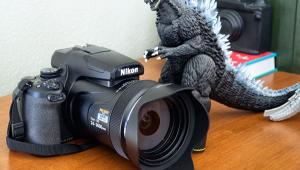Canon’s PowerShot G11; The G Series Evolves Page 2
How about Auto ISO? This selects the ISO for you depending on focal length of the 5x zoom (equivalent 28-140mm), the light level and shooting mode you happen to be using, and probably hedges the bet a bit more than your riskier shutter speed choices. (Keep in mind that IS is generally on unless you change its setting, for example, when you mount the camera on a tripod.) The Auto White Balance (WB) setting is quite uncanny, although my general choice is Daylight to catch the colors I see. Auto WB proved its mettle in a miserable fluorescent-lit commuter railway car where Daylight WB made all look sickly green and Auto made it look clean and neutral. I’ll stick with Daylight for most shots but would count on Auto in artificial light every time.
 |
|
|
The G11 is not a speed demon in framing rate, it being 1 fps in Continuous mode, although you can get a bit more speed by using Continuous AF mode, which locks the focusing point at dead center.
There are numerous Scene modes and processing choices in the Menu, most of which I consider window dressing but there if that’s what you like to do. You should know that you can view the scene in black and white via the Menu, but that if you ever want to see the scene in color again you should shoot Monochrome in Raw, not JPEG.
 |
|
|
How did I best enjoy working with the camera in the field? First I set it on center-weighted. I set it on Daylight WB (except for odd interior lighting). I locked exposure and used the screen as a live view exposure check. I easily moved between shutter- and aperture-priority as the scene dictated. I sometimes set it on Macro mode for close-ups. I did not use spot AF, manual focus, or other functions that were available but seemed to be unnecessary. (Although if you prefer spot reading, which is certainly viable with this camera, be sure that it is center point spot rather than chase focus around a small screen.)
There are some tricks in the camera worthy of mention. Focus bracketing can be used to take three shots so that the focus is on, in front of and behind the subject upon which you have focused. You can even set the gap between shots. Note that you have to shoot in manual, and that the interval in room light indirectly lit by sunlight was about a second between shots, so you have to keep the camera very steady or better yet mount it on a tripod. I found this feature interesting but of limited usefulness on this type of camera. Then there’s exposure bracketing (+/-2 EV in 1⁄3 EV steps). While many folks who use this camera as a traveling companion might not even bother with bracketing, those who enjoy tone mapping should be aware that it exists.
 |
|
|
One of the best tricks is the inclusion of a Neutral Density (ND) filter, as an option, built-in. For nature photographers with small tripods this might be worth the price of admission. The 8x filter is not achieved through underexposure, but drops light intensity as it is recorded. In the spirit of having an inch and wanting a yard, I now would like to have this in 2x and 4x options as well.
Shutter speeds can be used and set from 15 seconds to 1⁄4000 sec, an impressive range, while aperture goes from f/2.8 (at the wide setting) to f/8 on the 28-140mm (equivalent) zoom, but drops 1.5 EV as you zoom out to the longer settings, to f/4.5. Integral lens cameras are not ones to choose if you are a huge fan of bokeh, and this is no exception, though you can use manual focus at tele settings of f/4.5 to do your best, given the right subject/background distances.
There are numerous other tricks, including i-Contrast, sort of an auto tonal curve compensation, stitch assist for panoramas, and a Low-Light mode that can kick ISO up to 12,800. You can also shoot 640x480 MOV video, and the quality is good enough for a travel diary. You can set all sorts of effects on the movies, my favorite being shooting in black and white, for obvious nostalgic reasons.
Playback is becoming as complex as shooting menus and here you can choose numerous groupings and sorts. You can also play with post-exposure processing—always tricky on a small screen—but here you are limited to working with JPEGs only, the thinking being, I suppose, that you’ll want to play with the Raw files in the computer later anyway. You can also place images in categories so you can use slide shows, etc. to share your images, but here Canon gets to name the categories, not you.
 |
|
 |
|
|
Conclusions
The G11 scores high in accessibility to body (non-menu) controls for many essential field operations; a bright and readable display that really comes to the fore in low light; excellent image quality at reasonable ISO settings; live view-like settings linked to WB, exposure, and metering pattern controls; an exciting ND filter built-in; an articulating monitor that inspires unique points of view; and Raw and Raw+JPEG recording options.
On the other side of the coin, there’s a miserly viewfinder, a bit more heft and size that puts it out of pants or shirt pocket reach (though it is no bother in a coat pocket, backpack, or, I am sure, pocketbook), and some extras that are window dressing at best. The accompanying instruction book is sometimes opaque and confusing, and there are some functions that require too many steps, necessary I suppose because the G11 is trying to deliver items usually in the D-SLR realm that need gymnastics to perform in an integral lens model. And I would pay extra for a constant maximum aperture throughout the zoom range.
In all, the G11 proves itself to be an excellent traveling companion. I recently brought it along on a workshop shoot and most attendees felt that the articulating monitor was the best thing Canon did in this generation of the “G” line. Is this the ultimate and elusive second camera we are seeking here at the magazine? Close, but the hunt goes on.
For more information, contact Canon U.S.A., Inc. at: www.usa.canon.com.
- Log in or register to post comments

















































